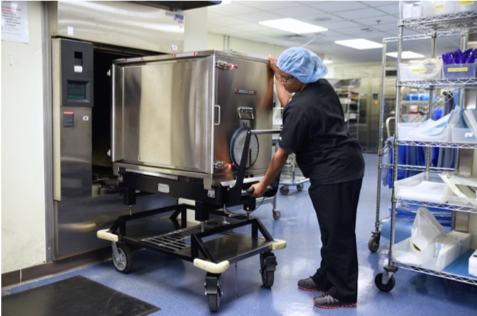The most valuable asset in your Operating Room is actually not the C-Arm or robotic console sitting over in the corner. It’s not even time. It’s your people. Without them, no patient gets wheeled back, no incision gets made, no tumor removed, and no baby gets a second chance at life.
If our people are our most valuable hospital asset, how should we think about every day workflows that could injure and harm them?
One of the most common complaints you will hear from Operating Room and Sterile Processing staff is the concern around heavy loaner and consignment instrument trays. These trays could weigh up to 25lbs* a piece and must be lifted, inspected, maneuvered, loaded, and unloaded up to a staggering hundred times a day by a single staff member in a busy hospital. There’s no wonder so many members of the perioperative team cringe when seeing large numbers of these trays set up for their particular case.
How to Protect your Most Valuable Assets
While this is a real challenge in many hospitals and ambulatory surgery centers around the United States, there are a number of things you can consider doing today to protect your people from harm:
1) Anti-Fatigue Mats Matter – While not flashy, anti-fatigue mats really can have a tremendous impact on technicians in SPD and the OR who have to stand long periods of time while lifting and maneuvering these heavy trays. Pay special attention to the expected lifespan of the product if one is given from the manufacturer, and inspect for damage and continued suitability on a regular basis.
2) Go Beyond Basic Ergonomic Training – Most facilities have some kind of limited training in ergonomics on an annual basis for all employees, but this does not necessarily translate easily in workflows that naturally involve tight spaces and the kind of twisting and turning that happens in loading and unloading loaner instrumentation. Building on basic ergonomic training that takes into account lifting of 25lbs, turning, and setting up a back table, for instance, can be helpful in standardizing safe movement and assist your team in identifying potential barriers to easy flow through the loading/unloading process.
3) Utilize Technologies that Hardwire Safer Practices – When it comes to loaner instrumentation and traditional packaging/container options, many of the products on the market do not account for ergonomic handling of the devices themselves. Rigid containers add additional weight to already heavy loaner trays and can make it difficult to easily remove internal contents in a sterile fashion. Disposable blue wrap requires the Sterile Processing team to individually wrap and load/unload each tray numerous times along a normal reprocessing workflow. In the OR, the blue wrap must be removed and heavy trays held outside the sterile field until any penetrations or packaging compromise is identified. This has to be repeated again and again for every wrapped tray needed for the case.
New multi-tray sterilization technologies such as the SteriCUBE™, were intentionally designed with OR and SPD end-users in mind, particularly in regards to keeping these team members safe from unnecessary workplace injury or harm due to the repetitive handling of heavy surgical instruments. The system is ergonomically designed to position instrument trays at the perfect height to decrease bending, lifting and reaching and to remain within the sterile field at all times while unloading. These kinds of innovations can have an impact on everything from worker’s compensation claims to employee satisfaction, not to mention cost and time savings.
If you haven’t considered the importance of ergonomic factors in your loaner and consignment instrument workflow before, this is a great opportunity to start a conversation with your OR and SPD staff to ask them where they hurt, and what your department can do to keep it from happening again. Any investment you make in the safety of your people will only increase the longevity and engagement of your most valuable asset – your people. It’s time you #SaveYourBack.
* AAMI ST79:2017 (8.2.(j)) states that “Instrument sets, including the sterile barrier system, should weigh no more than 11 kg (25 lbs)”


